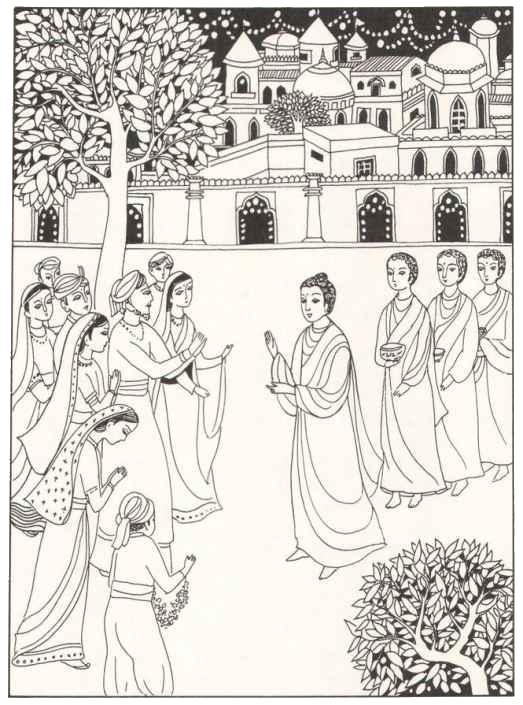
I heard these words of the Buddha one time when he was staying at the monastery in the Jeta Grove near Shravasti that had been donated by the layman Anathapindika. On that day, Anathapindika came with 500 other lay students of the Buddha to the hut where Shariputra resided. They bowed their heads in reverence to Shariputra and sat down respectfully to one side. Venerable Shariputra offered them skillful teachings, bringing them joy and confidence in the Three Jewels and the practice of the true Dharma. Then, Shariputra and the 500 laymen and women went together to the hut of the Buddha, where Shariputra, Anathapindika, and the other 500 laymen and women prostrated at the Buddha’s feet and sat down to one side.
When he observed that everyone was seated, the Buddha addressed Shariputra, saying, “Shariputra, if lay students of the Buddha, those who wear white robes, study and practice the Five Mindfulness Trainings and the Four Contemplations, they will realize without hardship the capacity to abide happily in the present moment. They know they will not fall into the realms of hell, hungry ghosts, animals, and other suffering paths.
“Such men and women will have attained the fruit of stream-enterer, and they will have no fear of descending into dark paths. They are on the way of right awakening. They will only need to return to the worlds of gods or men seven more times before attaining perfect liberation and the end of suffering.
“Shariputra, how do lay students of the Buddha, those who wear white robes, study and practice the Five Mindfulness Trainings and the Four Contemplations?
“Lay students of the Buddha refrain from killing, put an end to killing, rid themselves of all weapons, learn humility before others, learn humility in themselves, practice love and compassion, and protect all living beings, even the smallest insects. They uproot from within themselves any intention to kill. In this way, lay students of the Buddha study and practice the first of the Five Mindfulness Trainings.
“Lay students of the Buddha refrain from taking what has not been given, put an end to taking what has not been given. They find joy in being generous without expecting anything in return. Their minds are not obscured by greed or craving. They constantly guard their own honesty and uproot from within themselves any intention to take what has not been given. In this way, lay students of the Buddha study and practice the second of the Five Mindfulness Trainings.
“Lay students of the Buddha refrain from sexual misconduct, put an end to sexual misconduct, and protect everyone—those under the care of their father, mother, or both father and mother; their elder sister or elder brother; their parents-in-law or other in-laws; those of the same sex; the wife, daughter, husband or son of another; and those who have been raped, assaulted, or sexually abused, or who have been prostitutes. Lay students of the Buddha uproot from within themselves any intention to commit sexual misconduct. In this way, lay students of the Buddha study and practice the third of the Five Mindfulness Trainings.
“Lay students of the Buddha refrain from saying what is not true, put an end to saying what is not true. They say only what is true, and they find great joy in saying what is true. They always abide in truth and are completely reliable, never deceiving others. They have uprooted from within themselves any intention to say what is not true. In this way, lay students of the Buddha study and practice the fourth of the Five Mindfulness Trainings.
“Lay students of the Buddha refrain from drinking alcohol, put an end to drinking alcohol. They uproot from within themselves the habit of drinking alcohol. In this way, lay students of the Buddha study and practice the fifth of the Five Mindfulness Trainings.
“Shariputra, how do lay students of the Buddha attain the Four Contemplations and abide happily in the present moment with ease and without hardship?
They practice being aware of the Buddha, meditating on the one who has come from Suchness and returns to Suchness; as one who is truly and fully awakened, without any attachments; as one whose understanding and practice are perfect; as the Well-Gone One; as one who knows and fully understands the world; as one who has attained the very highest; as one who has tamed what needs to be tamed; as a teacher of humans and gods; as an Awakened One; and as a World-Honored One. When they meditate in this way, all unwholesome desires come to an end, and impure, sorrowful, or anxious elements no longer arise in their hearts. As a result of contemplating the Buddha, their thoughts are clear, they feel joy, and they arrive at the first of the Four Contemplations, abiding happily in the present moment, with ease and without any hardships.
“Shariputra, the lay students of the Buddha practice being aware of the Dharma, meditating as follows: the Dharma is taught by the Lord Buddha with great skill; it can lead to complete liberation; it can lead to a state of no afflictions; it is cool and refreshing; its value is timeless. When lay students of the Buddha meditate on and observe the Dharma in this way, all unwholesome desires come to an end, and impure, sorrowful, or anxious elements no longer arise in their hearts. As a result of contemplating the Dharma, their thoughts are clear, they feel joy, and they arrive at the second of the Four Contemplations, abiding happily in the present moment, with ease and without any hardship.
“Shariputra, the lay students of the Buddha practice being aware of the Sangha, meditating as follows: the noble community of the Tathagata is advancing in a good direction; it is on an upright path; it is oriented toward the Dharma; it lives the teachings in the way they are meant to be lived. In that community, there are the Four Pairs and the Eight Grades—realized Arhats and those who are realizing the fruit of Arhatship, non-returners and those who are realizing the fruit of non-returning, once-returners and those who are realizing the fruit of once-returning, and stream-enterers and those who are realizing the fruit of stream-entry. The noble community of the Tathagata has successfully realized the practice of the Mindfulness Trainings (shila), the practice of concentration (samadhi), and the practice of insight (prajña). It has liberation and liberated vision. It is worthy of respect, honor, service, and offerings. It is a beautiful field of merit for everyone. As a result of contemplating the Sangha, their thoughts are clear, they feel joy, and they arrive at the third of the Four Contemplations, abiding happily in the present moment, with ease and without any hardship.
“Shariputra, the lay students of the Buddha practice being mindful of the Mindfulness Trainings, meditating as follows: the Mindfulness Trainings have no drawbacks, flaws, impurities, or unsound points; and they help us abide in the land of the Tathagata. The Mindfulness Trainings are not of the nature to deceive. They are always praised, accepted, practiced, and guarded by the holy ones. As a result of contemplating these Trainings, the students’ thoughts are clear, they feel joy, and they arrive at the fourth of the Four Contemplations, abiding happily in the present moment, with ease and without any hardship.
“Shariputra, remember that white-clad disciples of the Buddha who practice in this way will not descend into hell realms, hungry ghost realms, animal realms, or any other realms of suffering. They have experienced the fruit of stream-entry, which means not falling into paths of hardship or wrongdoing. Having entered the stream, they cannot help but go in the direction of right awakening. They will only need to return to the world of gods or humans seven more times before they arrive at complete liberation and the end of sorrow.”
Thus spoke the Buddha. The Venerable Shariputra, the other monks and nuns, the layman Anathapindika, and the other 500 laymen and laywomen heard these words and were delighted to put them into practice.
Translated by Thich Nhat Hanh from the Upasaka Sutra, Madhyama Āgama 128.






Join the conversation